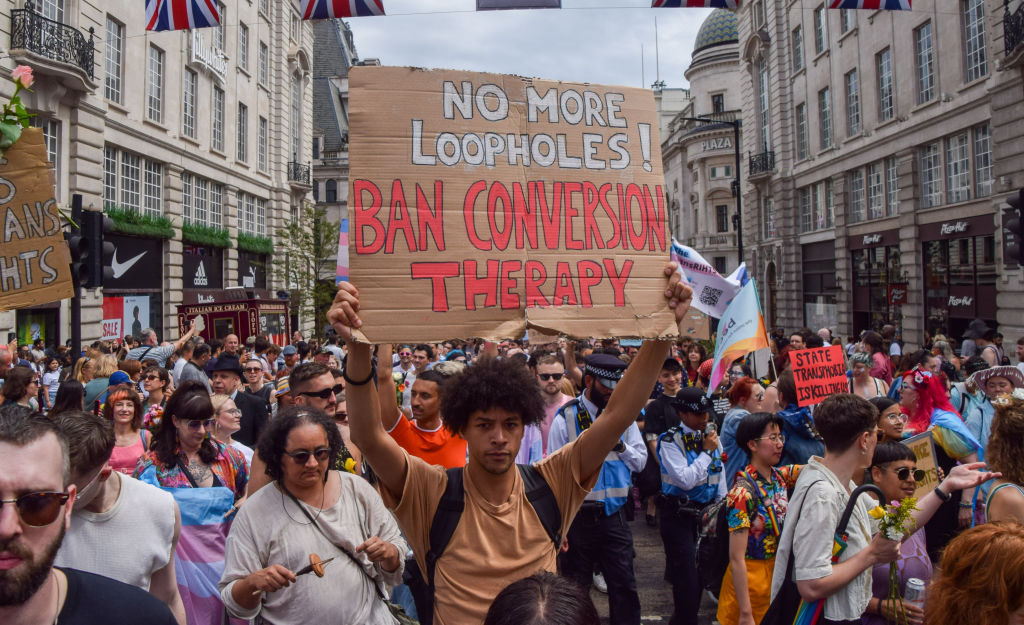Exclusive: Conversion Therapy Is Still Happening in Almost Every U.S. State
0 View
Share this Video
- Publish Date:
- 13 December, 2023
- Category:
- Natural Cures
- Video License
- Standard License
- Imported From:
- Youtube
Tags
>

Conversion therapy—a practice aimed at changing someone’s sexual orientation or gender identity—has been widely discredited and is banned in 22 states and the District of Columbia. But more than 1,300 practitioners still offer conversion therapy in the U.S., according to a new report shared exclusively with TIME.
[time-brightcove not-tgx=”true”]“It is shocking to still see so many different conversion therapy programs across the U.S., because all those programs are fraudulent,” says California Rep. Ted Lieu, who in June introduced a bill to ban conversion therapy at the federal level. “There is no scientific or medical basis for conversion therapy. It is a huge scam.”
The new report comes from the Trevor Project, a nonprofit that aims to prevent suicide among LGBTQ youth. Lead author Casey Pick, director of law and policy at the Trevor Project, says she believes it is among the most comprehensive efforts to document the prevalence of conversion therapy in the U.S. She spent five years combing through publicly available online listings for conversion therapists to counter the common—though mistaken—perception that the debunked practice has become obsolete.
A conversion therapist’s goal is usually to change their client’s sexual orientation or gender identity such that they identify as straight or cisgender. The practice has been condemned by numerous organizations specializing in psychiatry, health, and human rights, since it has been shown to be both ineffective and dangerous. People who go through conversion therapy are at increased risk of mental-health issues including depression, low self-esteem, substance misuse, and suicidal behavior, research shows.
“There is no evidence-based reason to engage in conversion therapy,” Dr. Amir Ahuja, president of the American Psychiatric Association’s LGBTQ+ Caucus, wrote in a statement to TIME. “Engaging in conversion therapy goes against the ethics and oath of medical practitioners.”
Almost half of U.S. states forbid licensed mental-health providers, such as therapists and psychiatrists, from offering conversion therapy to minors. (The Supreme Court recently rejected a challenge to Washington State’s ban.) Nonetheless, one recent study concluded that more than 10% of people in the U.S. who identify as a sexual or gender minority have been through conversion therapy, and previous Trevor Project research suggests about 17% of LGBTQ youth have either experienced or been threatened with it.
Curtis Lopez-Galloway’s parents started taking him to a Christian counselor—who turned out to be a conversion therapist—after he came out at age 16. In addition to pushing Lopez-Galloway to “adopt a more masculine persona” and become attracted to women, Lopez-Galloway says his counselor discouraged him from spending time with friends who supported his sexuality and stoked his parents’ fears about the risks their son might face as a gay man. “What my therapist did in the sessions was terrible, but that wasn’t the part that really, really got to me and messed me up mentally,” Lopez-Galloway says. “It was what would happen at home…because of what he was doing.”
Lopez-Galloway has since founded a support network for fellow conversion-therapy survivors and helped pass a ban in his home state, Illinois. The Trevor Project’s new report is important because people need to know that “it’s still happening,” he says. “Even though we have these laws on the books, it’s still not sufficient.”
Pick and her team found that at least 1,320 conversion-therapy practitioners are currently working in the U.S. She found therapists in every state except Hawaii and Vermont. Even in many areas where licensed mental-health providers cannot legally offer conversion therapy to minors, Pick found instances of professionals—including those licensed as counselors, therapists, and other mental-health providers—operating there nonetheless.
More than half of the practitioners identified in the report, however, offer conversion therapy through religious organizations. (About 100 of the practitioners in the report with religious ties also hold licenses to provide mental-health or medical care.) Religious-liberty protections mean they are largely exempt from state-level bans, although some plaintiffs have also sued religious conversion-therapy practitioners for fraud.
Pick notes that there are likely many more people offering clandestine conversion therapy. She and her team limited their search to publicly available online listings, which excludes sources like private social-media groups and practitioners who advertise solely through word of mouth. Since many practitioners have stopped using terms like “conversion therapy” and “reparative therapy” due to bans, they also looked for people advertising under other keywords, like “unwanted same-sex attraction.” Practitioners were only counted in the report if multiple researchers on Pick’s team agreed that they were explicitly engaging in the practice.
Although the report shows that bans do not entirely stop conversion therapy, Pick says she’d like to see even more enacted in the coming years. While most current laws apply only to licensed providers working with minors, she believes they have trickle-down effects.
Bans “send a powerful message…that [conversion therapy] doesn’t have the stamp of approval of the government that this is legitimate or scientific,” Pick says. “That is an important message to get out there.”












